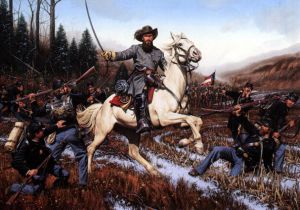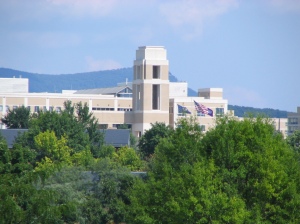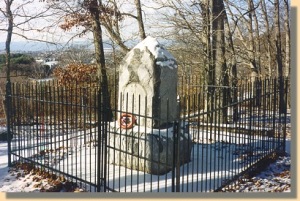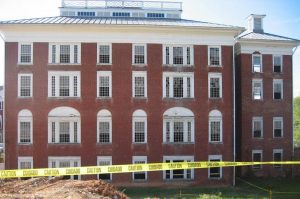Archive for April, 2007
 Check out a Google Map showing my top ten restaurants in Harrisonburg, VA.
Check out a Google Map showing my top ten restaurants in Harrisonburg, VA.
The Integrated Science and Technology (ISAT) program is relatively new at JMU, and it was created with the intention of developing problem solvers, technological communicators and life-long learners. According to ISAT’s website…
ISAT students are trained to use computers as problem-solving tool, collaborate in inter-disciplinary teams, and work in laboratory settings. The ISAT curriculum involves a range of study areas, called sectors. Here’s a list of the current sectors.
- BioSystems* (a.k.a. Biotechnology)
- Energy*
- Engineering and Manufacturing*
- Environment* (a.k.a Environmental Science)
- Health Systems*
- Information & Knowledge Management* (a.k.a. Computer Science)
- Telecommunications
- Social Context of Technology and Science
- Instrumentation & Measurement
In the first two years of the program, ISAT majors take classes from each of the main sectors (marked by *) . In the third year, students choose three sectors to examine further, and in the final year students concentrate on at least one of these sectors. One great aspect of the program is that students are allowed to devise “tailored” concentrations that align with their specific interests (e.g. E-Commerce, Geographic Information Systems).
In the spring semester of the Junior year, ISAT majors begin work on a 6-credit senior project, and students are responsible for selecting a project topic that is related to their concentration. During the spring of their Senior year, students must write a thesis paper and present the project to their peers and faculty.
After college many ISAT graduates work as consultants, project managers, and specialists in the private and public sectors. The average salary of a graduate coming out of the program is about $48,000. However, many students continue their education in Graduate School.
Today’s Daily News Record reported that JMU has requested $1 billion from the Virginia state legislature for new construction projects. The request was approved last month by JMU’s Board of Visitors, and it will have to approved by the state legislature in the next year before JMU can receive the funds. The DNR reported that JMU wants to use the $1 billion to “build a bigger football stadium, another parking deck, a biotechnology building, a new student health center and new student housing.” Additionally, the university plans on renovating 9 Bluestone buildings and the old Rockingham Memorial Hospital.
University officials have said that the $1 billion is essentially a “wish list,” and they don’t expect the legislature to approve the entire amount. The officials said that if JMU doesn’t receive the entire amount it requested, the university still plans on working on these projects in the next 10-15 years.
Currently, JMU is focused on completing projects that are already in progress:
- Patterson Street Parking Garage
- Performing Arts Complex
- Plecker Arboretum Education Building
- East Campus Library
- Miller Hall Renovations
First of all, I don’t think that JMU is going to get anything close to $1 billion, but it’s nice to know that university officials are looking to expand and improve the university. The project that intrigues me the most is the football stadium project. I don’t know if this means that JMU wants to build an entirely new stadium or expand Bridgeforth Stadium.
JMU just added the Plecker Athletic Performance Center and FieldTurf to Bridgeforth, so I don’t know why they would want to go out and build another stadium — except to make that jump to DI football. It’ll be interested to see how this plays out in the future.
Furthermore, if JMU had more high-profile alumni we wouldn’t have to be as dependent on state funds. The University of Virginia finances its projects primarily through private donations, and this independence has allowed UVA to take on major projects (e.g. John Paul Jones Arena, new South Lawn addition). JMU’s alumni base is gradually growing, but I think it will be awhile until JMU alumni can raise enough money to tackle the “Big Time” projects.
A city manager is an official appointed as the administrative manager of a city, and Staunton was the first city in the world to adopt a city manager form of government. Yesterday’s Daily News Leader had an interesting article on Stephen F. Owen, Staunton’s current city manager. Owen has just completed his first month on the job, and the article discusses how he’s handled the transition from Herndon and what he expects to do in the near future.
Owen said that so far he has only had to deal with “a man angry about a parking ticket and a lady concerned about a cat in a tree.” He is enjoying the slow-paced community, and he’s noticed several differences between Staunton and Herndon. “[In Staunton] if you decide to fix a sidewalk, you just fix it,” he said. “You don’t study it for three years.”
The new city manager will lead Staunton’s initiative to rejuvenate neighborhoods outside of the downtown area. Staunton plans to invest in alleys, sewers and new homes in the “Newtown” district.
Owen is following one of Staunton’s most successful city managers, Bob Stripling. Stripling’s five-year tenure was highlighted by economic development and investment in Staunton’s downtown. He’ll probably be remembered most for renovating the Stonewall Jackson Hotel and Conference Center, overseeing the trolley system, and pushing for wireless Internet access in the downtown district.
 Turner Ashby Monument. Ashby Crossing apartments. Turner Ashby High School. Who was Turner Ashby? Unless you’re a civil war expert like my roommate Rob, you probably don’t know who Turner Ashby was.
Turner Ashby Monument. Ashby Crossing apartments. Turner Ashby High School. Who was Turner Ashby? Unless you’re a civil war expert like my roommate Rob, you probably don’t know who Turner Ashby was.
Turner Ashby was a Confederate cavalry general in the Civil War. Ashby was born on October 23, 1828 in Faquier County, Virginia. When he was in his twenties, Ashby organized a local militia known as the Mountain Rangers. The Mountain Rangers were absorbed into the Virginia Militia in 1859 following the slave rebellion (led by John Brown) in Harper’s Ferry, West Virginia. Turner Ashby played an important part in the takeover of the West Virginia arsenal.
In 1861 Ashby came under command of Colonel Thomas J. “Stonewall” Jackson while serving at Harper’s Ferry. Ashby served as Jackson’s cavalry commander, and he was known as the “Black Knight of the Confederacy.” The “Black Knight” was an accomplished horseman, and he led many successful reconnaissance missions for Stonewall Jackson.
On June 6, 1862, Ashby and his men were attacked by the 1st New Jersey Cavalry near Harrisonburg, VA. During the attack Ashby’s horse was shot and he decided to charge ahead on foot. Within a few steps, he was shot through the heart and instantly killed. The Turner Ashby monument is said to be placed on the direct spot where Ashby died.
 The Wetsel Seed Company warehouse in Harrisonburg, VA was built in 1908, and it was originally used as a poultry-processing plant — it was once the largest poultry fattening facility in the world. In 1949 Wetsel Seed Company purchased the 50,000-square-foot lot, and they used it to store their seed. In 2005 Barry Kelley and Andrew Forward purchased the Wetsel Seed Company warehouse with the intention of constructing a mixed-use building.
The Wetsel Seed Company warehouse in Harrisonburg, VA was built in 1908, and it was originally used as a poultry-processing plant — it was once the largest poultry fattening facility in the world. In 1949 Wetsel Seed Company purchased the 50,000-square-foot lot, and they used it to store their seed. In 2005 Barry Kelley and Andrew Forward purchased the Wetsel Seed Company warehouse with the intention of constructing a mixed-use building.
Kelly and Forward have spent $5 million to renovate the building, and they finished their work in 2006 with the aid of state and federal historic tax credits. The newly renovated building is known as the City Exchange, and it provides apartments, offices, and retail space. The warehouse is now home to 32 apartments and Downtown 56, a 10,000-square-foot restaurant and martini bar. The renovated building is located in the north end of downtown Harrisonburg, and community developers hope that it will be a catalyst for downtown development.
 Staunton,VA is home to the former Western State Hospital, a hospital for the mentally ill, which originally began operations in 1828. In the 1970s Western State vacated the property and moved to a site near Interstate 81. The facility was then converted into the Staunton Correctional Center, a medium-security men’s penitentiary. In 2003 the Correctional Center shut down, and the facilities were vacated.
Staunton,VA is home to the former Western State Hospital, a hospital for the mentally ill, which originally began operations in 1828. In the 1970s Western State vacated the property and moved to a site near Interstate 81. The facility was then converted into the Staunton Correctional Center, a medium-security men’s penitentiary. In 2003 the Correctional Center shut down, and the facilities were vacated.
The former Western State Hospital is within walking distance of historic downtown Staunton, and the complex covers 75 acres. The complex borders Staunton’s business district near attractions such as the Blackfriar’s Playhouse, the Stonewall Jackson Hotel, and the Woodrow Wilson Birthplace and Museum. Five of the site’s 21 primary buildings are listed on the National Register of Historic Places, and the original buildings feature Jeffersonian influenced architecture. In fact, the original campus was built by the same masons who constructed the University of Virginia.
In 2004, the City of Staunton discussed transforming the Western State Mental Hospital into a vibrant, mixed-use pedestrian-friendly community. The City assigned the development team of Frazier and Associates of Staunton, Folsom Group of Charlottesville, Miller & Associates of Richmond, and the Arcadia Land Company of Wayne, Pennsylvania to the development project. The Folsom Group and Miller & Associates will lead the development project, and they want to build a mixed-use district with homes, restaurants, shops, and offices.
The new development will be named The Villages, and it will be completed in phases over the next 10 years. The team plans to renovate many of the existing buildings for new uses and construct new buildings. Renovation has begun on the first building, The Bindery (the largest in the complex), and this building will soon house nineteen single-level condominiums.
I think this project is a great idea. I’m always in favor of renovating existing structures for new developments, and the Western State Hospital complex certainly does have some beautiful buildings. However, even though I like this project I don’t think that I could ever live there. The idea of living in a room that was occupied by a mentally ill patient AND a prisoner does not appeal to me. I also wonder what the developers plan on doing with the grave site located behind the complex.
A video of a JMU college tour getting pranked. It’s funny, but it lasts 25 minutes.
 Science On a Sphere (SOS) is a three dimensional visualization tool that uses computers and video projectors to display animated data on a six foot diameter spherical projection screen. SOS was developed by the National Oceanic and Atmospheric Administration (NOAA), and it is primarily used as an educational tool to show planetary data. NOAA has developed imagery for geophysical, atmospheric, and oceanic data, simulation models, weather forecasts, and extraterrestrial bodies such as Mars, Venus, and the Sun.
Science On a Sphere (SOS) is a three dimensional visualization tool that uses computers and video projectors to display animated data on a six foot diameter spherical projection screen. SOS was developed by the National Oceanic and Atmospheric Administration (NOAA), and it is primarily used as an educational tool to show planetary data. NOAA has developed imagery for geophysical, atmospheric, and oceanic data, simulation models, weather forecasts, and extraterrestrial bodies such as Mars, Venus, and the Sun.
 The projection system consists of four projectors, four auxiliary computers, and one central computer. The projectors display the images on the sphere, and each one is managed by an auxiliary computer. The central computer controls and synchronizes the operations of the other four computers, and it is responsible for rendering images uploaded by users.
The projection system consists of four projectors, four auxiliary computers, and one central computer. The projectors display the images on the sphere, and each one is managed by an auxiliary computer. The central computer controls and synchronizes the operations of the other four computers, and it is responsible for rendering images uploaded by users.
The subject matter of the display material is essentially unlimited. Currently, I am working with the Shenandoah Air Quality Initiative (SHENAIR) to develop a tropospheric (ground level) ozone dataset for the SOS system that JMU recently purchased. The dataset will show the daily peak Air Quality Index (AQI) values for ozone in the United States from May 9th, 2002 to December 31st, 2006. JMU is the first university to acquire such a system, and my project is the first student project.
Welcome to WordPress.com. This is your first post. Edit or delete it and start blogging!






